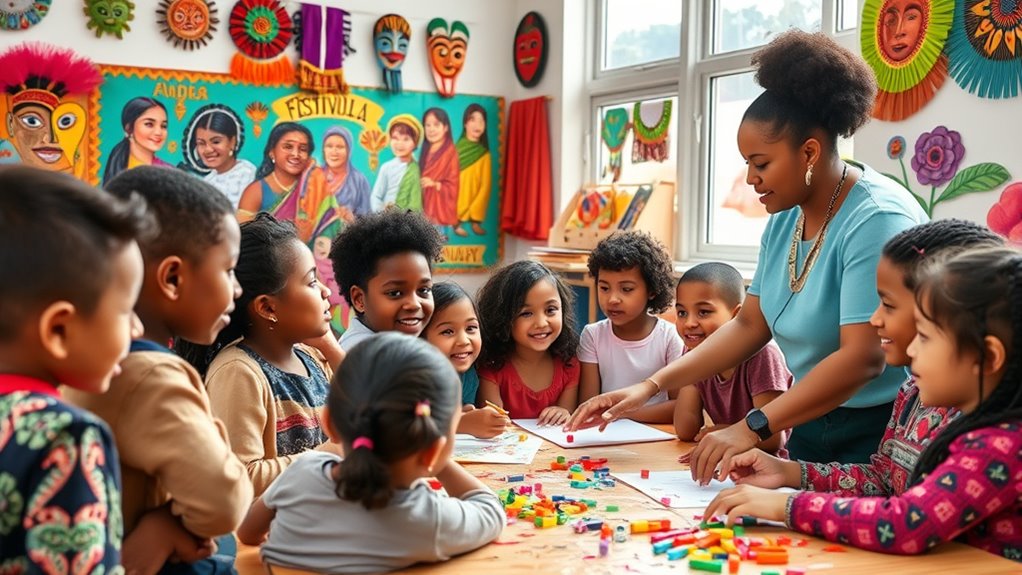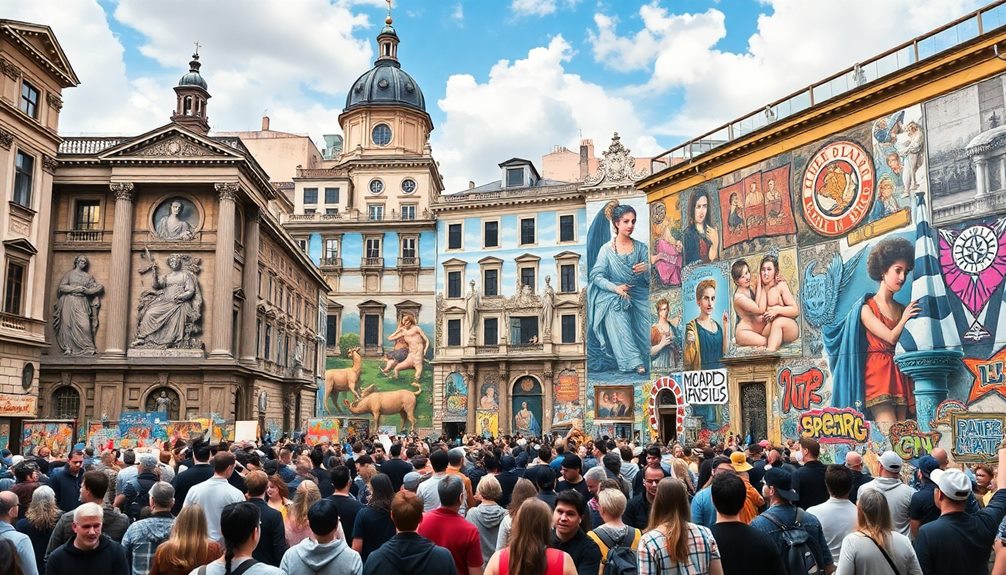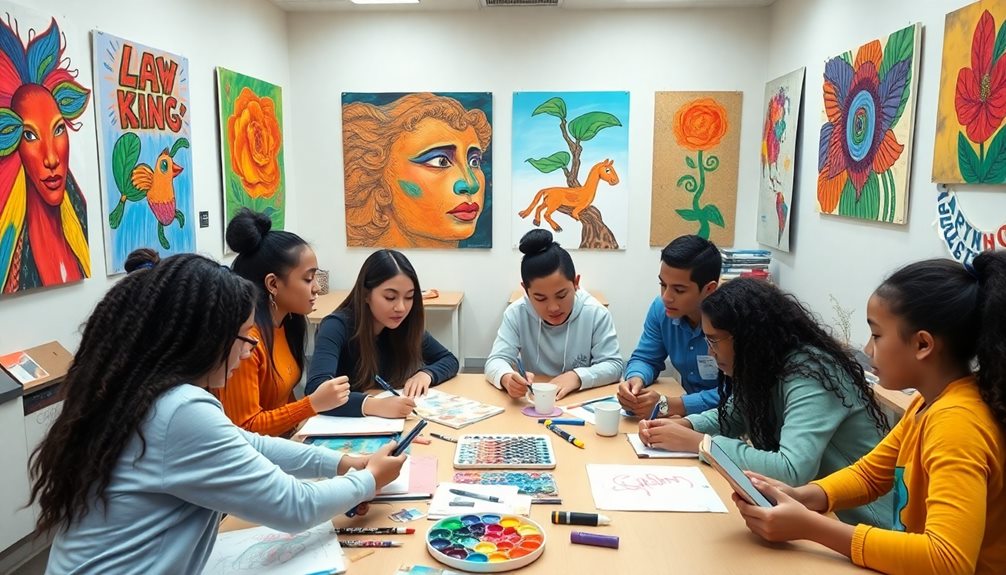To create culturally relevant art lessons, focus on incorporating diverse perspectives and authentic resources like traditional artworks, techniques, and storytelling. Use materials that reflect various cultural backgrounds and consider community input for respectful representation. Highlight different traditions and histories through project choices, fostering student exploration of their identities and promoting empathy. Address sensitivities by researching symbols and practices carefully. If you continue, you’ll discover effective strategies to embrace inclusivity and enrich your art curriculum.
Key Takeaways
- Incorporate authentic cultural resources like artwork, stories, and traditions to represent diverse perspectives accurately.
- Design lessons that explore multiple cultural narratives through storytelling, symbolism, and traditional techniques.
- Use diverse materials and media to showcase global artistic practices and respect cultural authenticity.
- Engage community members and cultural experts to ensure respectful, accurate, and meaningful representation.
- Regularly assess and reflect on lesson inclusivity, gathering student feedback to improve cultural relevance.
Understanding the Importance of Cultural Diversity in Art Education
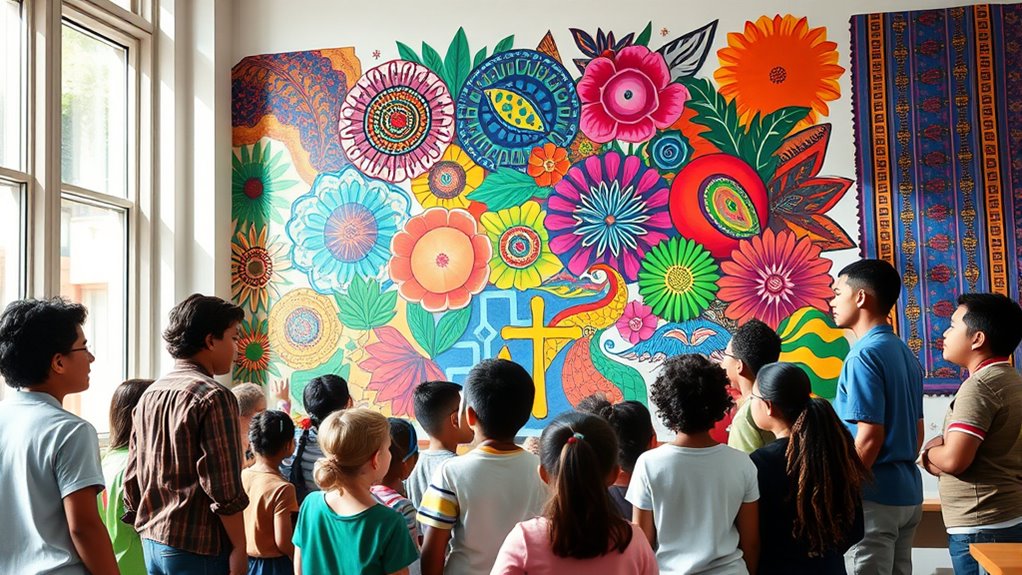
Understanding the importance of cultural diversity in art education is essential because it enriches students’ learning experiences and broadens their perspectives. When you incorporate diverse cultural elements, you foster cultural appreciation, helping students recognize and value different traditions and artistic expressions. This approach also supports the development of each student’s artistic identity by allowing them to explore and express their unique backgrounds. Embracing cultural diversity encourages open-mindedness and respect, creating a more inclusive classroom environment. As you integrate varied cultural perspectives into your lessons, you help students see art as a global language that connects people across cultures. Ultimately, this enriches their understanding of art’s role in society and nurtures their ability to appreciate and contribute to a diverse artistic landscape.
Selecting Inclusive and Representative Art Materials and Resources

Choosing inclusive and representative art materials is essential for creating a classroom environment that celebrates cultural diversity. When selecting resources, prioritize culturally diverse materials that reflect various traditions, histories, and perspectives. This inclusive resource selection guarantees students see themselves and others represented authentically. To aid your choices, consider this table:
| Material Type | Example | Cultural Focus |
|---|---|---|
| Paints & Textiles | Natural dyes from different regions | Indigenous techniques |
| Art Prints | Famous artworks from diverse cultures | Global artistic traditions |
| Craft Supplies | Traditional tools and materials | Cultural craftsmanship |
Additionally, incorporating diverse media broadens students’ understanding of various artistic expressions across cultures. Recognizing the importance of cultural representation in art education helps foster an inclusive environment that values all students’ backgrounds. Incorporating culturally relevant art also encourages students to explore their own identities and appreciate others’ heritage. Ensuring that artistic techniques are accurately depicted helps preserve the integrity of cultural traditions while promoting respect and understanding. Understanding the significance of cultural authenticity ensures that materials are respectful and accurately depict the traditions they represent.
Incorporating Global Artistic Traditions and Techniques

You can enrich your art lessons by incorporating diverse cultural materials and traditional techniques from around the world. These approaches allow students to explore global artistic influences and develop a broader understanding of creative practices. By doing so, you foster an inclusive environment that celebrates cultural diversity through art. Additionally, engaging with cultural impact of technology on artistic expression can deepen students’ appreciation for how modern tools influence traditional art forms. Recognizing the importance of authentic materials can help students better understand the significance of using genuine resources in traditional art techniques. Incorporating traditional techniques from different cultures can also inspire innovative approaches and broaden students’ creative horizons.
Diverse Cultural Materials
Incorporating diverse cultural materials into art lessons exposes students to a rich array of global artistic traditions and techniques. By exploring mosaic storytelling, you introduce students to how ancient civilizations used small pieces to craft compelling narratives. Textile symbolism allows them to understand how fabrics convey cultural values and identity across regions. Using these materials, you can create vivid imagery:
| Mosaic storytelling | Textile symbolism |
|---|---|
| Ancient murals with intricate designs | Traditional fabrics with meaningful patterns |
| Colorful tile arrangements | Embroidered stories on clothing |
| Cultural murals depicting legends | Symbols woven into textiles |
Additionally, integrating cultural symbolism helps students appreciate the deeper meanings behind artistic motifs from different societies.
Traditional Art Techniques
Have you ever wondered how different cultures develop unique artistic techniques that reflect their history and values? Many traditions rely on traditional brushwork and indigenous techniques passed down through generations. These methods often emphasize specific tools, materials, and cultural symbolism. For example, Chinese calligraphy uses precise brush strokes to convey emotion, while Indigenous Australian dot painting tells stories through layered patterns. Understanding these techniques deepens your appreciation of cultural artistry. You might explore:
- Traditional brushwork styles across Asia and Europe
- Indigenous techniques from Africa and Oceania
- The significance of natural materials used in traditional art
- Ritualistic methods and their cultural meanings
- How indigenous techniques preserve history and identity
Additionally, examining local adaptations and cultural influences reveals how communities incorporate their unique identities into traditional art forms. Exploring traditional tools and materials further highlights the importance of cultural context in shaping artistic expression. Incorporating traditional art techniques into your practice can also provide insight into the values and histories embedded within different cultures. Recognizing the cultural symbolism embedded in these techniques can enrich your understanding of their significance and deepen your artistic expression. Moreover, incorporating intergenerational knowledge ensures the preservation and continuity of these rich cultural traditions.
Global Artistic Influences
Traditional art techniques showcase the rich diversity of cultural expression, but many artists today blend these methods with global influences to create innovative works. By exploring cultural symbolism, you can incorporate meaningful motifs from different traditions, enriching your art’s narrative. Artistic fusion allows you to combine techniques like Japanese ink painting with African textile patterns or Latin American mural styles, highlighting shared themes across cultures. This approach broadens your understanding of global artistic traditions and encourages dialogue between diverse practices. As you incorporate these influences, you foster a deeper appreciation for cultural diversity and challenge conventional boundaries. Your artwork becomes a platform for cross-cultural exchange, demonstrating how blending traditions can produce fresh, meaningful perspectives rooted in global interconnectedness.
Designing Lessons That Celebrate Multicultural Narratives
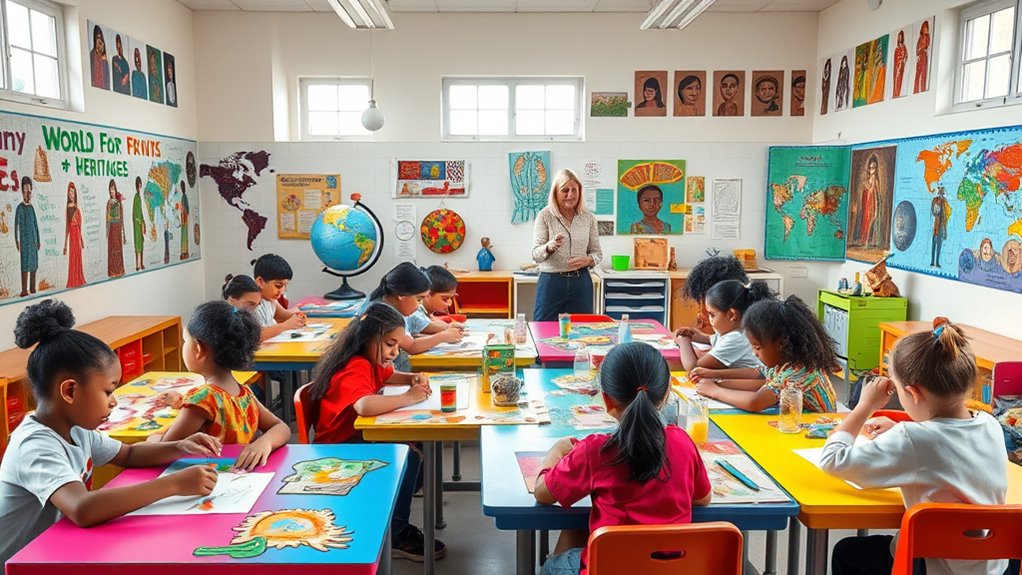
How can you craft art lessons that genuinely honor and reflect diverse cultural stories? Focus on integrating cultural storytelling to showcase different traditions, histories, and symbols. Use authentic resources like artwork, interviews, and literature from various cultures to inspire students. Encourage identity exploration by prompting learners to connect their own experiences with broader narratives. Incorporate activities that highlight storytelling techniques unique to each culture, fostering respect and understanding. To deepen engagement, consider these approaches:
- Invite community members to share cultural stories
- Incorporate traditional art forms and techniques
- Use multicultural themes for collaborative projects
- Explore symbolism and motifs in different cultures
- Facilitate reflection on personal and collective identities
- Cultural representation in art education helps promote inclusivity and a richer understanding of global diversity.
Additionally, integrating cultural storytelling techniques that emphasize authentic narratives can significantly enhance students’ appreciation for diverse perspectives. This approach guarantees your lessons celebrate multicultural narratives while promoting meaningful cultural storytelling.
Encouraging Student-Centered Exploration of Cultural Identities

What sparks meaningful engagement when students explore their own cultural identities through art? Personal storytelling is a powerful tool that encourages identity exploration. When you create opportunities for students to share their cultural experiences, they connect deeply with their work and each other. Invite students to express their backgrounds, traditions, and values through art projects that reflect their unique stories. This process fosters self-awareness and confidence, allowing students to see their identities as valuable contributions to the classroom community. By prioritizing student-centered exploration, you empower learners to take ownership of their cultural narratives. This approach not only enriches their understanding of themselves but also promotes empathy and appreciation for diverse perspectives among peers. Developing cultural intelligence can further enhance students’ ability to navigate and appreciate different cultural contexts in their artistic expressions. Additionally, incorporating diverse artistic styles and techniques can help students better understand and respect the variety of cultural influences that shape their own and others’ identities. Recognizing the importance of cultural representation in art can inspire students to explore and honor their heritage more intentionally, and understanding relationship dynamics can help them recognize the influences of family and community in their cultural stories. Engaging with personal development principles such as mindfulness and self-reflection can deepen students’ connection to their cultural stories and foster a more meaningful artistic process.
Addressing Challenges and Sensitivities in Culturally Diverse Art Content
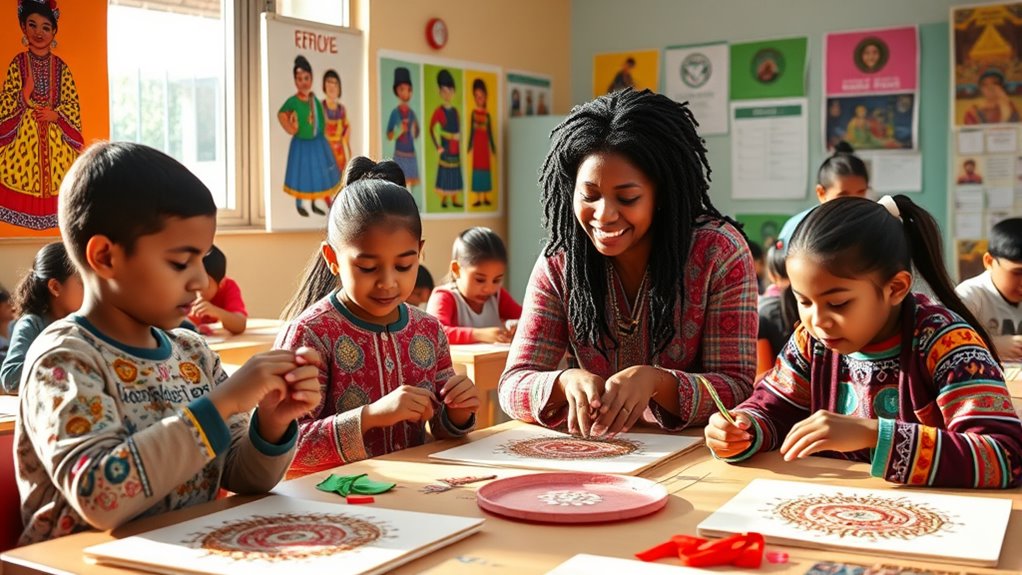
When incorporating culturally diverse art, you need to be mindful of sensitivities to avoid unintentionally causing offense. It’s important to recognize and challenge stereotypes and prevent cultural appropriation in your lessons. By approaching these topics thoughtfully, you create a respectful environment that honors all students’ backgrounds.
Navigating Cultural Sensitivities
Navigating cultural sensitivities in art lessons requires careful consideration and ongoing awareness. You must recognize how cultural insensitivity and art misappropriation can unintentionally offend or misrepresent communities. To foster respectful learning, consider these key points:
- Understand the origins of cultural symbols and practices before including them.
- Be aware of historical contexts that may influence perceptions.
- Avoid stereotypes that reinforce negative biases.
- Engage with community members to gain authentic insights.
- Educate students on the importance of respectful representation.
Avoiding Stereotypes and Appropriation
Addressing stereotypes and cultural appropriation in art lessons is essential to creating respectful and authentic learning experiences. Cultural stereotypes can unintentionally reinforce misconceptions or biases, so it’s important to challenge these in your teaching. When discussing diverse artworks, focus on the context and meaning behind the pieces rather than relying on superficial or stereotypical representations. Artistic appropriation, where you take elements from another culture without understanding or respecting their significance, can cause harm and perpetuate disrespect. To avoid this, encourage students to research and engage with cultures authentically, emphasizing collaboration and respect. By being mindful of these issues, you foster an inclusive environment that values genuine representation and deepens students’ cultural awareness.
Assessing and Reflecting on Inclusive Practices in Art Curriculum

Evaluating and reflecting on inclusive practices in your art curriculum is essential for creating a learning environment that truly respects and values diversity. Your assessment strategies should measure not only student skills but also cultural relevance and inclusivity. Reflective practices help you identify gaps and biases, guiding continuous improvement. To deepen your understanding, consider:
Regularly assess and reflect to ensure your art curriculum celebrates diversity and fosters inclusive learning.
- Gathering student feedback on cultural representation
- Analyzing diversity in your lesson content
- Observing student engagement across different backgrounds
- Reviewing your materials for cultural sensitivity
- Collaborating with diverse community members
Frequently Asked Questions
How Can Teachers Handle Cultural Misunderstandings or Misrepresentations in Lessons?
You can handle cultural misunderstandings by fostering cultural sensitivity and encouraging open dialogue. When misinterpretations happen, address them respectfully, clarify any misconceptions, and listen actively to students’ perspectives. Use resources that promote accurate representations, and involve community members or cultural experts when possible. This approach not only prevents misinterpretation but also creates a safe space where students feel valued and understood, enriching the learning experience for everyone.
What Strategies Support Shy or Reluctant Students to Share Their Cultural Perspectives?
Did you know shy students are 50% less likely to participate in class discussions? To support them, focus on building trust by creating a safe, inclusive environment. Use encouraging participation techniques like small group work or one-on-one conversations. Respect their comfort levels, and gradually invite their perspectives without pressure. This approach helps shy students feel valued and confident sharing their cultural stories at their own pace.
How Can Art Lessons Address Sensitive Cultural Topics Respectfully and Thoughtfully?
You can address sensitive cultural topics by fostering cultural sensitivity and encouraging respectful representation in your art lessons. Start by creating a safe space where students feel comfortable sharing their perspectives. Incorporate diverse artworks and discussions that highlight different cultures thoughtfully. Emphasize the importance of understanding and respect, guiding students to explore cultural themes with empathy. This approach guarantees your lessons are inclusive, respectful, and enriching for all students.
What Methods Ensure Ongoing Student Engagement With Diverse Cultural Art Forms?
To guarantee ongoing student engagement with diverse cultural art forms, you should facilitate cultural exchange activities that encourage students to share their own experiences and backgrounds. Incorporate ongoing reflection sessions where students analyze what they’ve learned and how it influences their understanding. By creating a safe space for dialogue and active participation, you foster deeper connections and sustained interest in different cultural perspectives through art.
How Do Teachers Evaluate the Authenticity of Cultural Content Used in Lessons?
You need to trust your instincts when evaluating cultural authenticity. To do so, verify content validation through reputable sources, consult cultural experts, and listen to community voices. Avoid taking shortcuts or relying solely on surface-level information, as that’s like putting lipstick on a pig. Instead, immerse yourself in genuine resources and stay open to feedback, ensuring your lessons respectfully and accurately represent the cultures you’re teaching about.
Conclusion
By embracing diverse perspectives in your art lessons, you open your students to a richer world of creativity and understanding. While celebrating different cultures fosters connection and empathy, it also challenges you to navigate sensitivities with respect and care. Ultimately, your role isn’t just teaching techniques but shaping open-minded individuals. In this balance between celebration and sensitivity, you create an inclusive space where every student’s identity is valued — a true reflection of art’s power to unite.
